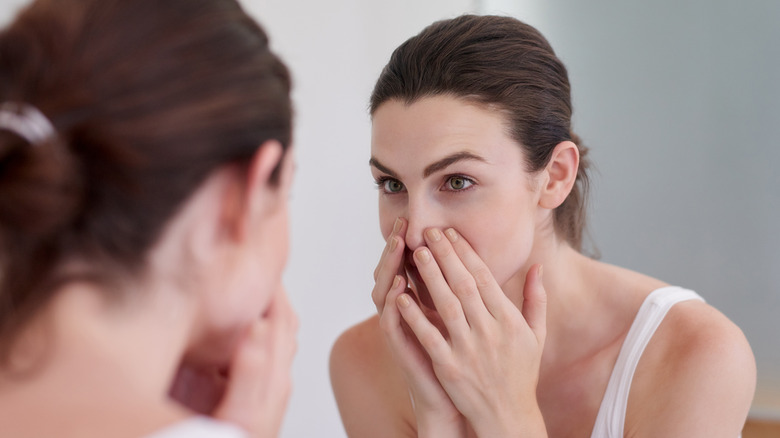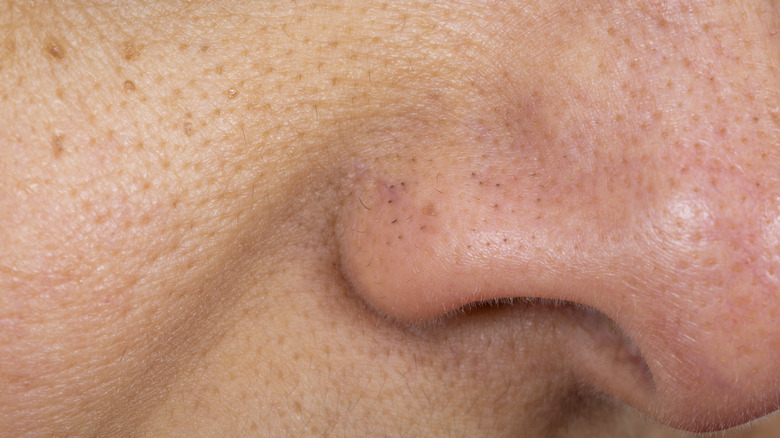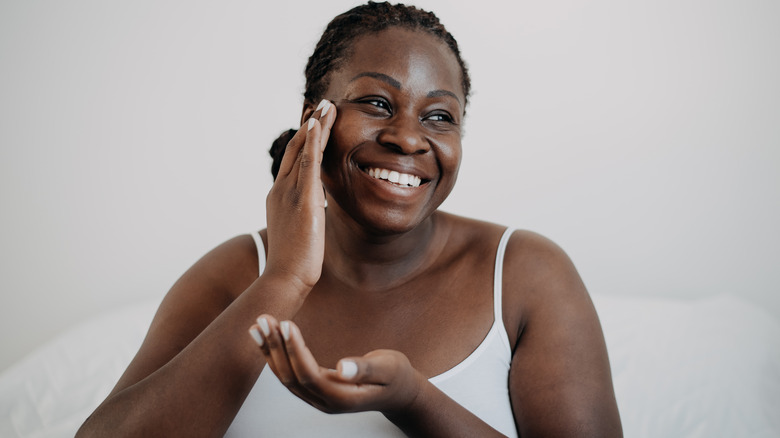Here's The Real Difference Between Sebaceous Filaments And Blackheads
Who among us isn't guilty of staring at our faces in the mirror, inspecting every "imperfection" we see on our skin? On one hand, it's a helpful practice in familiarizing ourselves with changes in our skin condition, which could signal underlying health issues. On the other hand, it's a slippery slope toward developing a fixation over the smallest things. Once every spot or blemish feels like a problem that must be treated, it becomes yet another source of distress.
Such is often the case with sebaceous filaments. Frequently mistaken for blackheads, thanks to their high concentration around the nose and the forehead, these thin, threadlike features line the insides of the sebaceous glands in our pores and perform the necessary function of moving sebum, or oil, to the skin's surface to keep it hydrated. They're part of every pore's anatomy and, unlike blackheads, aren't a type of acne. "Blackheads are darker and tend to have a texture to them," dermatologist Dr. Brendan Camp explained to Byrdie. "Sebaceous filaments are a normal skin finding; they feel smooth, do not block pores, and everyone has them."
They do become more visible whenever there's an excess production of sebum and oil fills up the pores. Compared to blackheads, though, they're smaller and lighter in color, ranging from yellowish and light brown to gray, per the Cleveland Clinic. When squeezed, they pop out small, yellowish, and waxy threads — quite different from the oxidized (and therefore darker) buildup of sebum and dead cells yielded by blackheads.
Sebaceous filaments become more visible due to certain factors
While they're a normal part of the dermis, sebaceous filaments are more obvious on oily skin because of how frequently the pores get filled with sebum. Cleveland Clinic also cited thicker hair follicles as a contributing factor to their increased visibility. Both causes are determined by one's genetics.
However, certain lifestyle practices definitely contribute to how obvious one's sebaceous filaments become. One is the use of harsh cleansers and astringents that leave the skin dried out and trigger the sebaceous glands to produce excess oil. Prolonged sun exposure has also been discovered to be a possible cause of the enlargement of pores, which enhances the sebaceous filaments' visibility.
It's tempting to pop out your pores' contents to "clean" them once they become noticeable whenever you look in the mirror. Medical News Today stressed, though, that having visible sebaceous filaments isn't an indication of having dirty skin. Furthermore, esthetician Renée Rouleau told Byrdie, "Even if you extract or squeeze sebaceous filaments, they will fill up again within 30 days." Any kind of extraction done on them also spreads bacteria on the skin, making it more prone to irritation and breakouts that could lead to infection and scarring. Another terrible side effect of messing around with your sebaceous filaments? "Constant manipulation of the pores over time can actually make them bigger as the collagen breaks down," dermatologist Dr. Purvisha Patel told Teen Vogue.
Sebaceous filaments are natural parts of the skin's composition
So what are we supposed to do with our sebaceous filaments? Honestly, nothing. Dermatologists all advise leaving them alone. As tempting as it is to squeeze them out, they're natural parts of the skin's composition that perform a crucial function.
If you're uncomfortable with how visible yours look, your best bet for minimizing their appearance is helping regulate your skin's oil production. Start by using products formulated for your skin type to maintain its moisture balance and keep your sebaceous glands from overproducing sebum. Choose those that are gentle and non-comedogenic as well so they don't contribute to pore-clogging buildup. Mount Sinai School of Medicine assistant clinical professor Dr. Jeannette Graf further advised doing double cleansing, telling Teen Vogue, "Using a cleansing oil before your face wash is also key to make sure you are removing all your makeup and outside pollutants."
Regular exfoliation with retinoid- or beta hydroxy acid-formulated scrubs, pads, or gels also keeps your pores clean and healthy, resulting in their improved appearance, according to dermatologist Dr. Shari Marchbein (per Byrdie). Just be mindful of how your skin would react to any product and ingredient you introduce to your beauty regimen. It's always ideal to consult with your dermatologist first and do a patch test before going all in on a new skincare haul. Finally, daily moisturizing and applying sunscreen remain important for the overall health of your skin.


